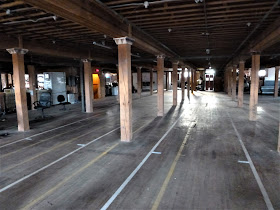That's actually a tricky question. Do we compare ourselves to our Rookie selves of last year? To other second year teams? To the "elite" teams that we have become aware of after leaping head FIRST into the world of competitive robotics?
Build and Software teams continue to work on parallel tracks. I understand from speaking with the "Softies" that they have many things working but that other functions are proving to be tricky. Our job on Build team is to have a robot ready when they want to transfer the competition control system over. I figure we will be there early next week.
Although we have effectively all of last year's team back again, it is actually a very different group this year. Veteran members now have more demands on their time from jobs and such. A few who had a clear niche last year don't have such obvious assignments this year, what with a very different kind of machine under construction. Oddly, or perhaps not so oddly, our younger and newer members have in some ways been carrying a lot of the work load. And doing well with it.
Example one. We actually have two middle schoolers on the team. With the collective student brains making little headway on a mechanism for our winch to engage the climbing rope I sat the two young cubs down at our battered shop desk and told them to come up with something.
What they drew up - then cut and welded - was a remarkably effective bit of engineering whose only downside was that in its initial version it bore a creepy resemblence to an iron swastika! With the edges smoothed down and the dimensions modified it will be perfect.
 |
| Hmmm, lets work on that a bit. |
Working in variously sized groups they produced four proposals in addition to our earlier one. Two looked very promising. One was a bit dubious due to complexity. And one simply ignored my specifications and solved the problem a different way.
I did not like this last plan very much. I had them rough it out in wood and put it through vigorous testing, trying to make it fail. I could not.
So we are building it. It will be less complex than what the "elite" teams are doing but with the added advantage of early completion and lots of practice time I think it will serve with distinction.
Some week three pics..
With bemused admiration for those teams who create their robot entirely on a computer then send the files off to be professionally cut, I prefer our way. Cutting and grinding in our welding area.
It looks as if we will have the time, weight and space allotments to attempt a ball shooter as our third priority system. The team likes to play around with the launching mechanism. I only let them do so when other, higher priority work is complete. It sure launches that wiffle ball...but the trajectory is unpredictable.
Our rope climbing mechanism was a bit over engineered....it was a boat winch capable of handling 500 pounds mated to a converted CNC tool changing gearbox. So obviously the solution was.....even more over engineering. We actually do have some mechanical engineers helping coach the team, and in consultation with our build kids a remarkable gearbox was located. Made of aluminum it is fairly light, well within our weight constraints. And it takes things to ridiculous levels...
There are two options for a whiffle ball shooter, high and low. Of course the points are different and sentiment on the team is to "aim high". But in the meantime experiments go on with a low target shooter. We needed a regulation dimension target, one we can move around easily. The first version was sloppy work, heavy and poorly made. Somebody threw a ball at it, it tipped over and broke. Version 2.0 is simply clamped onto our solid steel robot transport cart.
At roughly the half way point in build season we have our primary and practice robots both looking like this:
The earlier plywood front has been replaced with beautiful clear quarter inch polycarbonate. The gear collecting system is flawless. We have some tinkering to do with the gear release, maybe another day or two. I am advised that the completed lift winch is maybe two days off. Some sort of ball shooter that can be effective at point blank range looks to be seven to ten days away.
So.......doing OK.

















































